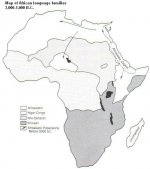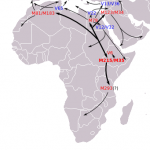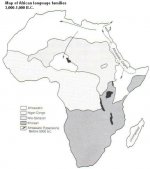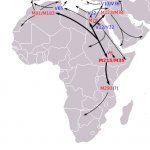You have an utter lack of mainstream support for your stance. In other words you have absolutely no scholarly basis to assert that this peer reviewed finding is incorrect:
Since when does "lack of mainstream support" (never mind the fact that "mainstream" is a bit relative anyways when talking about this topic!) equate with "I have absolutely no scholarly basis"? I have provided you with a source (Diakonoff, 1998, in the journal of semitic studies - "The earliest semitic society"), and I have promised that I will post more later here.
Keita (an authority) considers your position of a non African origin for this language family as "laughable".
Regarding Keita, it should be pointed out that he's not a geneticist, he's not a linguist and he's not archaeologist either, but a physical anthropologist. I'm not saying that this means that he has no authority (I surely believe that he has authority as a physical anthropologist), but I certainly raise an eyebrow when you call him "
an authority that considers my position laughable" and continue to insult me. You don't win discussions with such statements.
Me merely pointing out your reasoning is flimsy, should be the least of your worries!
Consider yourself officially warned. You are walking on
very thin ice right now.
The response by Ehret et al. to your assertion:
Ehret's counter-arguments are standing on shaky ground themselves. Perhaps you can explain to me why the reconstructed terms for instance for domesticated animals clearly match that of a pastoralist society? What purpose would a hunter-gatherer society have for terminologies that differenciate between young, male and females of a type of animal that was domesticated, from the perspective of the hunter-gatherers,
at a later point?
Why are you insisting on asserting your opinion as an "authority"?
I'm not asserting my opinion as an authority, but I'm bringing up valid counter-arguments. My authority comes from these counter arguments, not vice versa.
Here are the diversion times which are supported by several methods:
Well, they do something that really casts doubt on their authority on this issue: they cite Gray and Atkinson 2003: they claimed that Proto-Indo-European was a
Neolithic language that originates in Anatolia. Does this sound familiar? How can PIE be a Neolithic language if there's common terms for metal-working in Proto-Indo-European? You have a similar problem with neolithic Proto-Indo-European (
the Anatolian hypothesis, which Gray and Atkinson 2003 supported) as with mesolithic Proto-Afroasiatic.
Another refuted claim on your behave:
How does this refute my claim? I didn't speak in favour or against Demic diffusion. What the article you quote acknowleges is that farming arrives from the Middle East in Egypt, and it's thus absolutely compatible with the Neolithic/Eurasian origin of Proto-Afroasiatic.
You cannot simply keep dismissing the words of these reputed because you don't like their ideas.
Who is the one here who keeps dismissing an idea because he doesn't like it?
If your opinion is in line with the majority of modern linguist then provide support for your thoery or just drop it.
What? I'm supposed to drop my views because they are not in line with the majority of linguists? That is not how science works. It's possible that the majority of linguists are simply wrong on the topic.
Why are you sidestepping every scholarly opinion that I put fourth which refutes your claims? You don't address their legitimacy, but you instead just outwardly say that they were wrong because you say so. It simply does not work that way. Once again this statement from Frigi et al will explain the support that Capsian culture was indeed proto Berber:
I don't say that they are wrong because I say so. I say that they are wrong because I have well-grounded counter-arguments (both linguistically and genetically), and I also provide you with a chance to disprove my own hypotheses. As I have stated, if you can provide me with linguistic evidence that Proto-Berber was indeed a hunter-gatherer language, then I am willing to believe you that the Capsian Culture is indeed viable as a candidate for speakers of Proto-Berber. I am however quite confident that Proto-Berber can be reconstructed as a Neolithic pastoralist language, which clearly rules out the
Mesolithic Capsian Culture. Besides, Frigi et al. argue for
genetic continuity between the Capsian Culture and the modern-day Berber populations. This, in no way, stands in any contradiction to the idea that the Proto-Berber languages may have only arrived in northwest Africa with the Neolithic.
The problem with your theory is that you basically saying that the R Haplogroup followed along lingusitic lines, when it clearly did not. The populations with the highest frequencies are Niger Congo speakers (the Mande) and other West/Central African non Afro-Asatic speaking populations.
No, I'm not explicitly saying that Y-Haplogroup R
1b is following linguistic lines, because it clearly isn't. However, you have the case of an Y-Haplogroup that originated in Eurasia and migrated into Africa. Amongst other populations, R1b-V88 is also found amongst Semitic peoples in the Middle East, amongst Egyptians and amongst Berbers, all which are Afroasiatic-speaking peoples. From this area, R1b-V88 must have spread southwards into the Chad region, and then why does it not make sense to assume that these same people who spread R1b-V88 were also speakers of Proto-Afroasiatic? Regarding the highest frequencies being purportedly in Niger-Congo speakers, while that is possible, could you please cite the source for that? The
source that I cite clearly shows that it's most prevalent amongst Chadic speakers.
It's an unavoidable question and you know it. Why do populations in interior Africa have frequencies of up to 100% of a suppositely non African genetic marker who recieved this from a relatively recent back migration according to you (carried by people who are presumed to be non African in phenotype) look physically indistinguishable from their E carrying African neighbors? Im aware that a haplotype is not the sole determinant of phenotype, but this question still remains in the air.
Well, in my book that question is pretty meaningless. As I have stated before, there is no evidence that Y-Haplogroups have any effect on phenotypical appearance. Besides, there's an analogue for this from the Indo-European context: Both eastern Europeans and Indians, as you may know, do predominantly have Y-Haplogroup R1a. However, autosomally (autosomal admixtures), only a small percentage of Indians correspond with Eastern Europe autosomal admixture. So, if we consider the Indo-European immigration into India, and consider factors such as warfare, polygyny and other factors, we can indeed explain how this would result in Y-Haplogroups becoming dominant, whereas at the same time the corresponding autosomal DNA got dilluted. It is my opinion that when the Proto-Chadic peoples arrived in the Chad region, a comparable scenario might have happened. I admit that this is just a hypothesis, but since R1b clearly originated in Eurasia, one needs to come up with a scenario to explain the prevalence of this Haplogroup in the Chad region.
Regarding Haplogroup J1, you're very selective what your read. In that quote it said "Neolithic or earlier", which does not explicitly rule out Neolithic as wrong. Besides, as I have stated, it is
in the Caucasus you find the more archaic varieties of J1 (J1*, ie
not part of the major subclade J1-P58). If you, additionally, consider that
Haplogroup J2 also originated in the Near East, this means that this is evidence for a migration from the Middle East into Africa. Otherwise, I'm curious how you come up with a scenario why J1 is so abundant amongst certain populations in the Caucasus.
Thus, it shows that
both Y-Haplogroups J1 and R1b-V88 provide evidence for ancient migrations out of the Middle East into Africa. What pattern matches with this genetic data other than an Eurasian (and thus likely Neolithic) origin of Proto-Afroasiatic?






